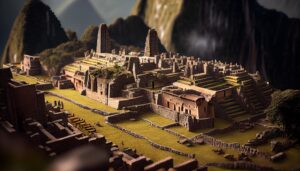
Ancient civilizations stand as the bedrock of human progress, laying the foundations for culture, governance, and societal development. In this article, we’ll journey through the history of ancient civilizations, exploring the remarkable achievements and legacies of these cultures.
Mesopotamian Civilizations
The ancient civilizations of Mesopotamia, including the Sumerians, Babylonians, and Assyrians, thrived in the fertile lands between the Tigris and Euphrates rivers. They established the world’s earliest cities, developed writing systems such as cuneiform, and made significant contributions to mathematics, law, and astronomy.
Egyptian Civilization
Ancient Egypt, known for its pharaohs, pyramids, and the Nile River, developed a sophisticated society with advancements in architecture, medicine, and the arts. Their intricate hieroglyphic writing and monumental structures like the Great Pyramids remain iconic symbols of ancient ingenuity.
Indus Valley Civilization
The Indus Valley Civilization, centered around modern-day Pakistan and northwest India, was one of the world’s earliest urban societies. Known for advanced city planning and drainage systems, this civilization developed a script that remains undeciphered, leaving behind intriguing relics and mysteries.
Ancient Chinese Civilization
The ancient Chinese civilization, characterized by dynasties like the Shang, Zhou, and Qin, produced remarkable technological and cultural achievements. Inventions like paper, gunpowder, the compass, and the Great Wall stand as enduring contributions to human history.
Greek and Roman Civilizations
The ancient Greeks and Romans made indelible marks on Western civilization. Greek philosophers, artists, and mathematicians laid the groundwork for science and philosophy, while the Roman Empire’s governance, engineering, and legal systems influenced Western societies for centuries.
Mesoamerican Civilizations
Civilizations in Mesoamerica, such as the Olmec, Maya, Aztec, and Inca, achieved impressive architectural and astronomical feats. They constructed monumental cities, developed complex calendars, and made significant advancements in agriculture and art.
The Persian Empire
The Persian Empire, led by figures like Cyrus the Great and Darius I, was known for its vast territorial expanse and efficient administration. Its legacy included the establishment of the world’s first postal system, the development of a common currency, and significant advances in governance and cultural exchange.
The Phoenicians
The Phoenicians, known for their maritime expertise, established city-states along the eastern Mediterranean coast. They were skilled seafarers, traders, and navigators, contributing significantly to the spread of writing systems, such as the alphabet, and fostering trade networks across the ancient world.
The Hittites
The Hittites, an ancient Anatolian civilization, left a legacy of sophisticated metallurgy and chariot warfare. They also produced one of the earliest known peace treaties, the Treaty of Kadesh, with ancient Egypt.
The Caral-Supe Civilization
The Caral-Supe civilization, located in modern-day Peru, was one of the oldest known urban settlements in the Americas. Known for its unique architecture and complex society, it developed monumental structures, pyramids, and an advanced understanding of irrigation systems.
The Aksumite Empire
The Aksumite Empire in present-day Ethiopia was a significant cultural and trading center. It controlled trade routes and was known for its distinct obelisks, advanced coinage, and its role in the spread of Christianity in the region.
The Harappan Civilization
The Harappan Civilization in the Indus Valley, known for its large urban centers like Mohenjo-Daro and Harappa, had sophisticated city planning, advanced drainage systems, and a script that remains undeciphered.
The Nabateans
The Nabateans, an ancient Arab people, established the city of Petra in present-day Jordan. They were skilled traders, creating an extensive network of trade routes and developing remarkable hydraulic systems for water management in their desert environment.
The Moche Civilization
The Moche civilization, located in what is now northern Peru, was known for its exceptional pottery and sophisticated metalwork. Their intricate ceramics depicted scenes of daily life, religion, and rituals, providing invaluable insights into their culture.
The Chavín Culture
The Chavín culture, based in the Andean highlands of Peru, developed a complex religious and artistic tradition. They created monumental stone architecture and were influential in the spread of religious symbolism across the region.
The Etruscans
The Etruscans, an ancient civilization in Italy preceding the Roman Empire, excelled in metallurgy, art, and city planning. Their influence on Roman culture, especially in architecture and religion, was significant.
The Olmec Civilization
The Olmec civilization, located in Mesoamerica, was known for colossal stone heads and early monumental stone architecture. They established the foundations for later Mesoamerican cultures like the Maya and Aztec.
The Shang Dynasty
The Shang Dynasty in China, among the earliest Chinese dynasties, developed a complex system of writing. Their oracle bone inscriptions offer significant insights into their history, society, and beliefs.
Conclusion
The ancient civilizations, each with its unique contributions and cultural legacies, form the cornerstone of human development. Their achievements in art, science, governance, and technology have profoundly influenced the course of history, leaving an enduring impact on the world. Understanding these ancient cultures offers insights into the origins of human progress and the remarkable ingenuity of our ancestors. We hope this exploration of ancient civilizations provides a glimpse into the rich tapestry of human history and the diverse paths of human achievement.
